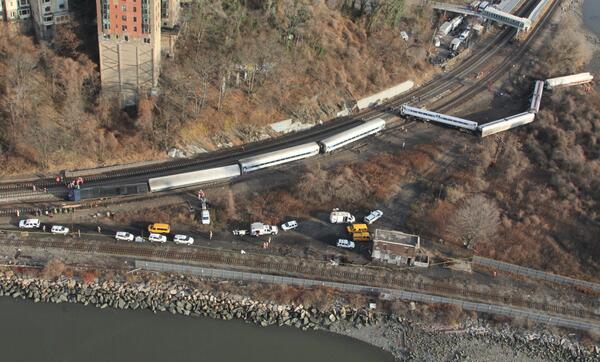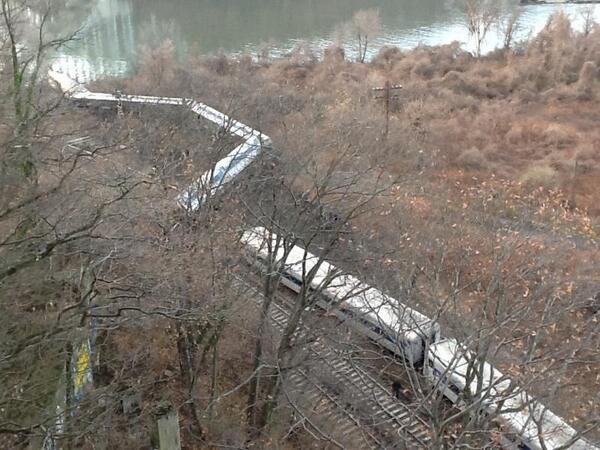Over the past few days, amidst an MTA crisis, New York Gov. Andrew Cuomo has again grabbed the mic to be the public face of an agency in trouble. This follows a trend established during Superstorm Sandy and one we’ve seen over the first few years of Cuomo’s tenure. He’ll issue the press releases and be on the air when someone needs to take charge, but he otherwise hasn’t embraced transit at all.
A telling moment came on Monday morning, in fact, when Cuomo was making the rounds on the local TV and cable news morning shows. One anchor asked Cuomo when he last took the train, and Cuomo, who has lived in Westchester for years and worked in an office the city as Attorney General, declined to answer. It was essentially a tacit admission that Cuomo hasn’t take the train in years. He should be ashamed. He’s the governor of the most transit-rich state in the country, and millions of his constituents depend upon subways, the LIRR and Metro-North every day. I don’t expect him to ride the 6 every day as Bloomberg does, but a trip now and then on a train would do him good.
Cuomo’s apathy, if not, as in the case of the Tappan Zee, outright hostility, does not bode well for anywhere else in the country, and following on the governor’s dismissal of a traffic pricing plan, that’s the argue Alex Pareene pursues in a piece at Salon. “The congestion pricing argument,” Pareene writes, “has always taken place, rhetorically, in a bizarre alternate universe where everyone drives, and where every citizen deserves to be able to drive without bearing anything close to the cost of that driving on the city’s infrastructure and atmosphere.”
He extends this discussion to the general approach to transit in the area:
Cuomo isn’t at all unusual. In New York state, as in the country as a whole, more resources continue to be spent on drivers and roads than buses and trains. One transit blogger has calculated that, according to how Albany allocates transportation money, “every driver is worth as much as 4.5 transit riders.” And while Mayor Bloomberg’s administration has a generally very good record on transit, there’s always been a strange tension between Bloomberg’s pedestrian and bicycle-friendly Department of Transportation and his NYPD, which has a bizarrely antagonistic relationship with bicyclists and which rarely — as in almost never — prosecutes reckless driving, speeding, or accidents leading to the death of pedestrians.
This should be the most transit-friendly government in the country. A majority of New York citizens rely on public transit for their livelihoods. The city and state are run by Democrats, many of them among the most liberal in the nation. Our incoming mayor, Bill de Blasio, ran as a left-wing populist. But incoming Mayor Bill de Blasio is a driver. Andrew Cuomo has been a driver, or had drivers, his entire life. There are certain richer Manhattanites, accustomed to walking, for whom anti-car policies improve their quality of life, but for most of the political class, everyone they know and interact with owns a car. Finding a steady and sufficient revenue source for the local transit system, one that can’t be raided for other purposes and that doesn’t rely too heavily on burdening its users with hefty fare increases, should be an urgent priority for local politicians, but most of them simply don’t care.
We already have a political system in this country that, nationally, heavily favors the interests of the rural and the suburban over the urban. Many state legislatures have similar biases. But when, even in New York, politicians ignore transit, because they don’t know or interact with or receive checks from people who rely on it every day, there’s almost no hope for cheap, efficient mass transit options anywhere.
Pareene’s last observation — that New York politicians “don’t know or interact with or receive checks from people” whose lives are dependent on transit — is a stunning one. In a city in which everyone takes and needs transit, those who fight for the system aren’t elected to City Hall or Albany. There are always a few bright spots, those legislators who understand the need, but they are few and far between.
So what’s the answer to this question? Is there one? The Straphangers Campaign has been fighting for 30 years; the Riders Alliance has been around for two. Still, there’s no indication that de Blasio will be better than Cuomo or that either will make the hard choices to fund transit. Even in a crisis three or four years ago, politicians couldn’t step up, and Eliot Spitzer, a big transit champion, self-destructed. So here we are in a city trying to find a way to fund transit in a sustainable way and continuing to face political road blocks. The fight will go on.







